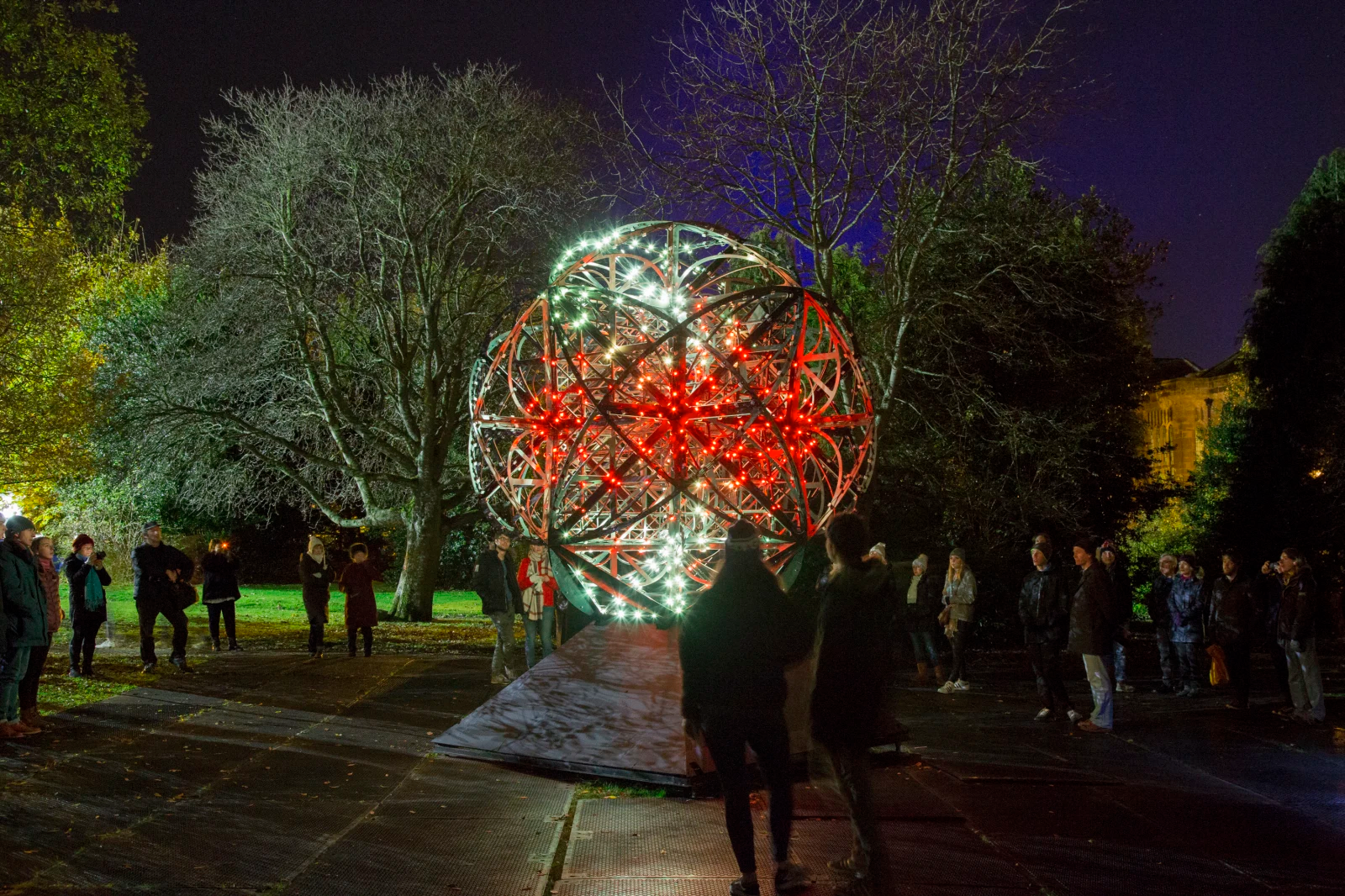
Published September 2025 as part of the proceedings of the first Alpaca conference on Algorithmic Patterns in the Creative Arts, according to the Creative Commons Attribution license. Copyright remains with the authors.
doi:10.5281/zenodo.17084442

Cosmoscope is an interdisciplinary project led by professor Simeon Nelson, researched and produced in collaboration with an expert team of artists and scientists culminating in a monumental sound and light sculpture. Inspired by historical astronomical instruments and models of the cosmos, it looks at the infinitesimal to the infinite. Like the world with its calamities and ceaseless change, Cosmoscope has order and disorder built in. Its patterns of light and music intertwine and separate in perpetual evolution giving rise to very small, the human and very large scales sourced from the research into solid-state physics, organic structures, and the large-scale structure of the cosmos.
Extending the research of previous projects including Anarchy in the Organism1 and Plenum2, Cosmoscope’s purpose is to define human biology in terms of its wider context, to investigate the contingency of our particular bio-medical and experiential makeup by asking: How does formation occur at sub-atomic, cellular, human, terrestrial and cosmological levels? Are there underlying symmetries that occur across these scales? How does the human body and psyche relate to its situation within the cosmic order?
Cosmoscope envisions a “great chain of being” starting at the quantum vacuum of virtual particles popping in and out of existence at the very tiniest scales in empty interstellar space; of the chemical dance of atoms combining into molecules; of molecules combining into cells then on to the bio-medical level of the growth of blood vessel networks and so on to the largest structures of the observable universe. Cosmoscope’s premise is that the exploration of this nested holarchy of scales that contains humans roughly at the midpoint allows us to more fully and truly know our own human situation and nature by contextualizing our biology rather than looking at in isolation. Cosmoscope invites us to rethink our identity and relationship to what is.
The animated imagery and sound of this spectacular light machine will be witnessed in loops of patterns in perpetual evolution, inspired by the awe and wonder we feel when contemplating the enormity and complexity of the cosmos. Informed by collaboration with leading physicists working at the scales of the very small, the human and the very large, Cosmoscope expands from biomedical science into earth science and astrophysics to offer a compelling narrative of the origin, evolution and nature of life. It looks at how wider phenomena impact biology, ultimately asking how we as humans arose within the cosmos.
Supported by Wellcome Trust, The Arts Council England, Durham Council, Durham University, University of Hertfordshire and in-kind support from industry.
Simeon Nelson: Lead Artist Rob Godman: Sound Artist Nick Rothwell: Visual Designer and Implementer Premiered 16th–19th November 2017, Lumiere Durham
The Holohedron (the physical artifact of the Cosmoscope project) is a spherical metal sculpture approximately 3.5 metres in diameter, weighing two tons and containing 2000 RGB LEDs mounted within a complex structure of intersecting metal rings of various sizes and orientations. In effect, it is a three-dimensional display whose LEDs are laid out geometrically, but not according to any kind of cartesian grid, and not spaced regularly in any dimension. Instead, the LED positions are specified through a series of mathematical equations, placing them around circles which are oriented at various geometric angles.
Based on the equations for the geometric form, every LED’s position can be determined in three dimensions. The circles themselves are actually positioned on the faces of nested tetrahedra within the device’s enclosing sphere, so there are internal triangular surfaces which could be addressed as flat irregular low-resolution display “screens” - and we do this, as described later.
The resolution and spacing of the LEDs makes it unsuitable as a display for realistic visual assets (still images or video), and in any case the project’s research topic (natural phenomena on scales that are either pan-galactic or microscopic) does not lend itself to photorealistic imagery.
The LEDs were driven by Novastar A45 receiving cards in four video wall driver systems and a MCTRL300 LED Display Controller3. We had to generate pixel-perfect bitmaps to an HDMI output to drive the visual display. A major complication in programming the Holohedron was the physical wiring of the LEDs. Approximately fifty LED strips were threaded through the structure, following a pattern laid out by the AV company in charge of the lighting installation, and not directly related to the mathematical enumeration of the LEDs. As a result, a mapping had to be drawn up between the two-dimensional addressing of the LEDs in the driver hardware (strip number and offset) and the three-dimensional position of each LED. The mapping was constructed manually by observation, LED by LED.
The display system was developed using a pre-visualisation “digital twin” of the hardware, written in ClojureScript and rendered using THREE.js in a web browser. We dispensed with any development effort that would be required to render realistic shadows or propagation of illumination: that would be a complex undertaking, and given the abstract mathematical nature of the display material, we were confident that something which looked good on screen would also be compelling on the physical structure. This indeed turned out to be the case.
Given the Holohedron’s weakness for displaying any realistic visual assets, we opted instead for abstract material of an algorithmic (equation-based) or geometric nature. We contemplated the pre-rendering of material, but we were faced with building our own software to do so, so it made sense to just do the visual generation directly on-device in real time. This made synchronisation to the dynamically-generated soundtrack easier, but a downside was a lower-than-ideal final frame rate (approximately 10 frames per second on 2017 hardware) due to the CPU load of calculating LED values - there was no obvious way to bring a GPU to bear on the task. In fact, some of the more CPU-intensive generator functions were implemented in Emscripten4, called via a ClojureScript wrapper.
We developed two distinct rendering models: one which targeted a virtual 2-dimensional surface, and one which rendered into the device’s enclosing three-dimensional sphere. These models were not mutually exclusive: the 2D render was a specific mapping within the 3D scheme, so animations of both kinds could be shown simultaneously, and multiple 2D animations could run at once. (One higher-order mapping we developed supported square visuals which were then “folded” along a tetrahedral edge and onto two triangular sides.)
This kind of mapping scheme was informed by the way we built Plenum
(although it’s a fairly obvious approach and has no doubt been used in
digital art elsewhere: the interested reader is referred to the
literature on scalar fields). Here, any displayed pattern on a canvas of
discrete points is implemented as a function from a point’s position to
the displayed value. In the image of Plenum below, the display function
maps point position (x,y) to point size, so even though the
points are arranged irregularly, and are constantly moving, visual
artifacts like the concentric rings remain in a stable position.
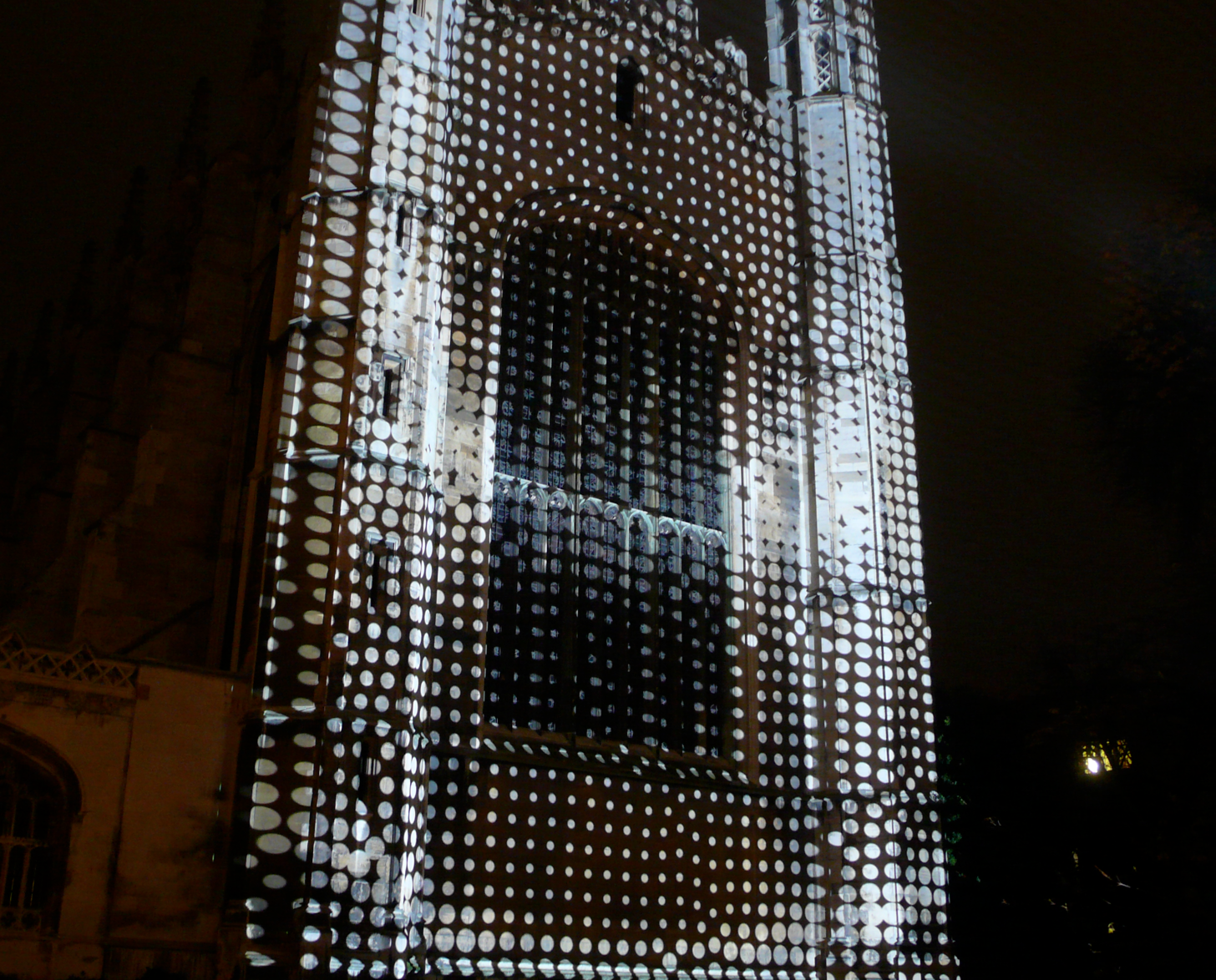
Such scalar field functions have numerous advantages:
t representing timeThe Holohedron operates via combinators over scalar functions in
(x,y,z,t), where t is time, and we have a variety of test
animations, such as those using trigonometry to rotate visual elements,
or produce periodic animation patterns (with trigonometry over
t). That gets us from a “model” parameter space operating
in three-dimensional Cartesian space (and possibly implemented in
Emscripten, as we described earlier) to the internal surfaces in the
Holohedron.
As an example, suppose we really do want to draw things accurately on
one of the triangular faces. We can do that by doing our drawing in
Cartesian space, in one plane (with, say, z=0 for
simplicity) and then shifting the appropriate part of the plane into the
coordinate system of the Holohedron itself using an affine
transformation. Here is an illustrated example: we have a generator
function which lights up the X-Y plane, by returning 1 for
all points very close to z=0 and 0 otherwise.
(For now we’re working in monochrome, for simplicity; the generators can
switch between scalar and RGB colour values as needed.) To illustrate
that, we temporarily replace the Holohedron form with a 3D Cartesian
point grid (since our entire rendering system is agnostic of the final
layout of light sources):
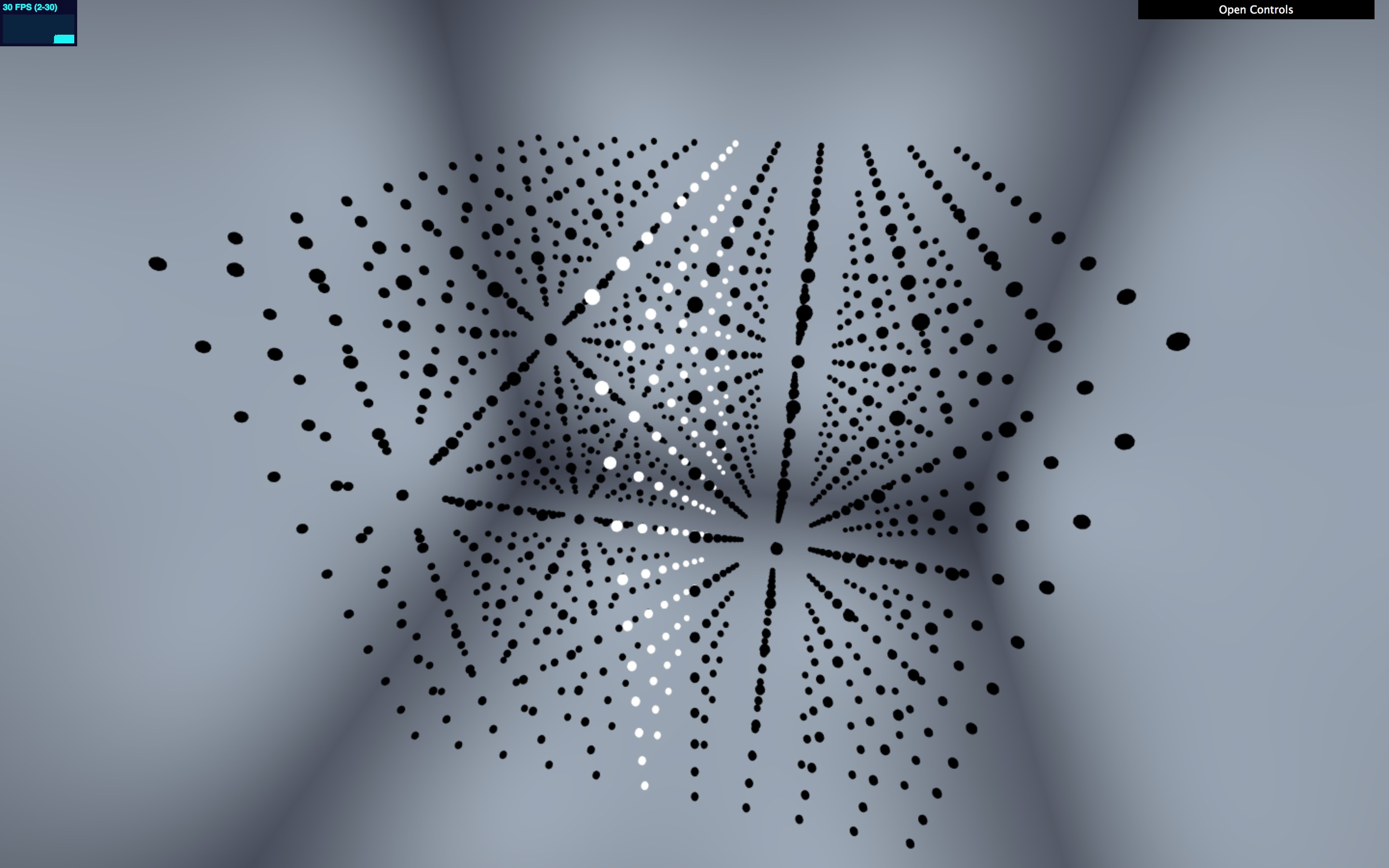
Now we need to shift this generator function from the
z=0 plane to a plane which coincides with a face of the
Holohedron. Here’s what that looks like if we keep the Cartesian grid in
place:
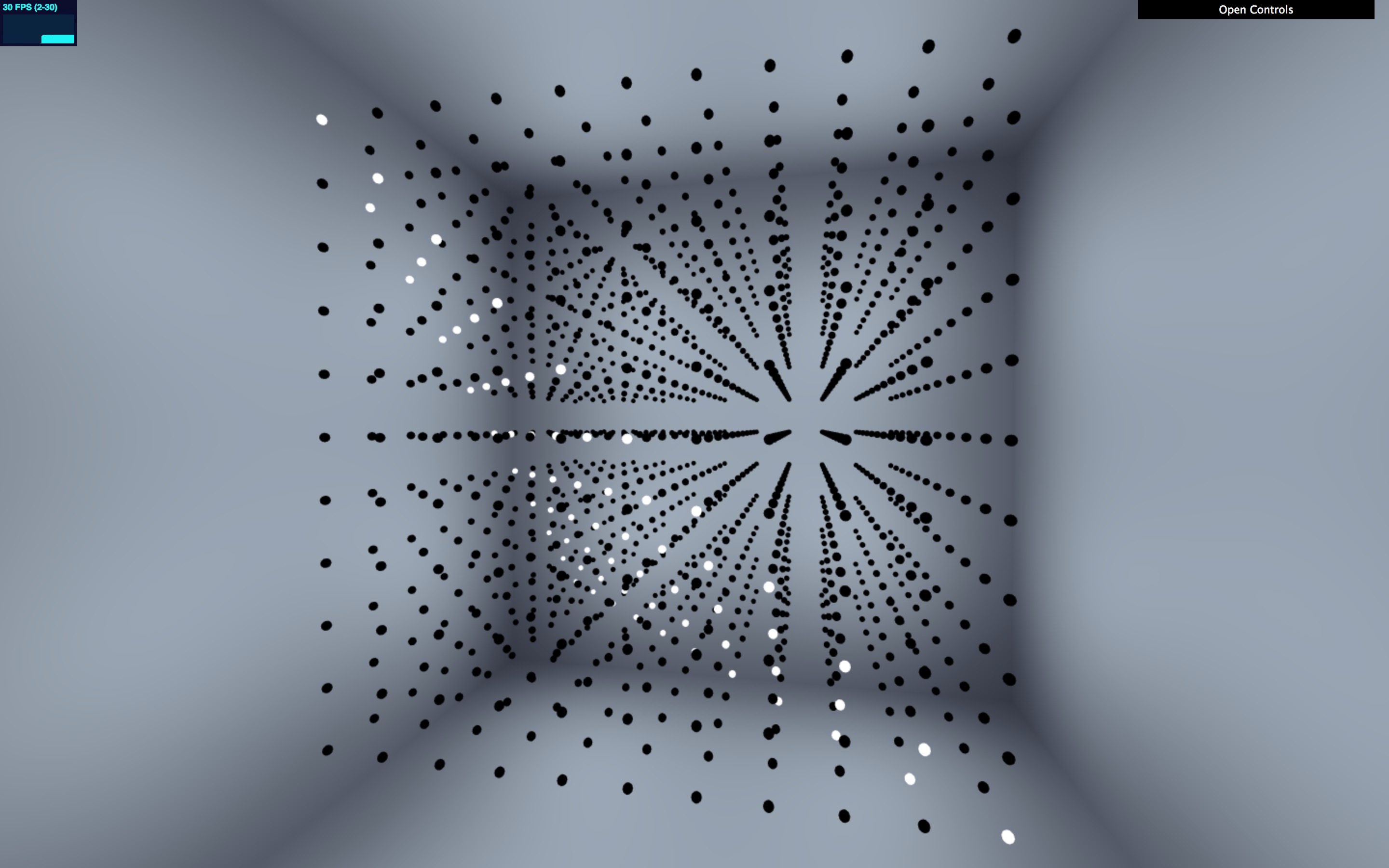
And now let’s swap the Cartesian grid out and put the Holohedron (or rather, cut-down a tetrahedral rendering of it) back:
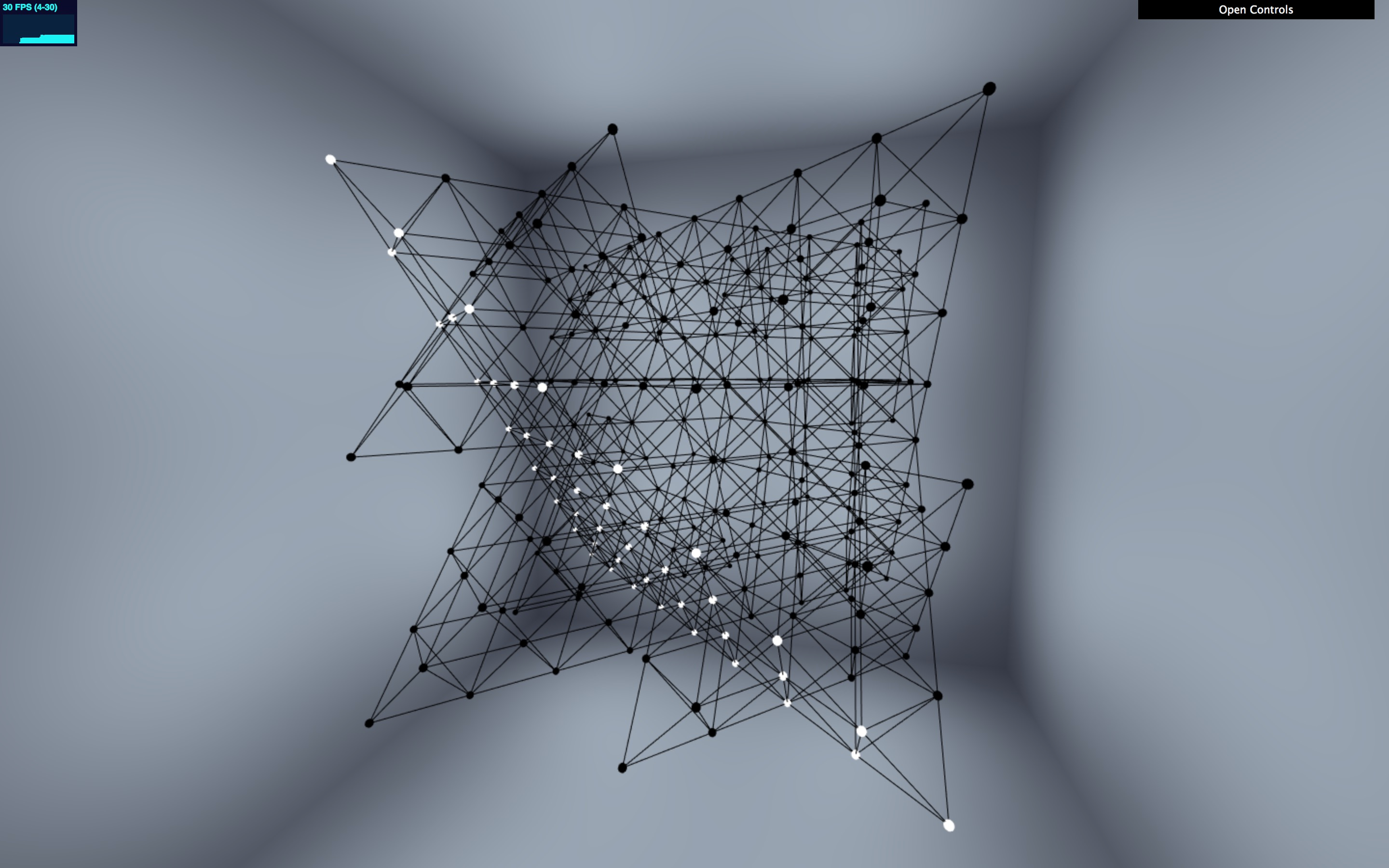
And here’s the code:
(def tetra-plane
(gx/affine-generator [[-1 -1 1] [1 -1 -1] [-1 1 -1]]
[[-1 -1 0] [1 1 0] [1 -1 0]]
(gx/z-proximal-generator 0
(gx/wrap-basis-fn 0 (fn [x y z t] 1.0)))))Let’s read that from the inside out. (fn [x y z t] 1.0)
is the initial generator which just outputs white (1.0)
everywhere. The z-proximal-generator transforms that into a generator
which puts out its value of 1.0 near the z=0
plane and fades it to zero away from that plane. Then the
affine-generator shifts the display. Anything we look at on the plane
[-1 -1 1] [1 -1 -1] [-1 1 -1] (the Holohedron tetrahedral
plane) will be calculated by looking at the enclosed generator on the
plane [-1 -1 0] [1 1 0] [1 -1 0], which is specified by a
triangle of three distinct points where z=0.
The affine mapping is beyond the scope of this paper, but we should
explain the wrap-basis-fn call. The functions over
(x,y,z,t) which we’ve called “generators” are better
described as “basis functions”. (That’s not an accurate use of the
mathematical term, but we stole the usage from Jitter5.)
Once we started working in Emscripten, it became clear that we’d
probably be working with generators which have a non-trivial iteration
from one time interval to the next (and possibly side-effecting too). An
obvious example of this is Game of Life, which of course we were
compelled to implement. So, it made sense to separate the advance of
time from the “sampling” operation at (x,y,z). Hence,
generators. (Think of this as currying a function over t as
first argument.) This is the Clojure protocol:
(defprotocol GENERATOR
"Generator form which separates time progression from x/y/z sampling."
(locate [this t]
"Locate to time `t`, return new state. (For Emscripten generators,
may well just side-effect.)")
(sample [this x y z]
"Sample state at current time and `(x, y, z)`. Return single value
or RGB triple."))It’s trivial to take a basis function over (x,y,z,t) and
turn it into a generator:
(defn wrap-basis-fn
"Wrap a simple `(x, y, z, t)` basis function into a `GENERATOR` form."
[t f]
(reify GENERATOR
(locate [this t']
(wrap-basis-fn t' f))
(sample [this x y z]
(f x y z t))))And so to the money shots. We have a Game of Life implementation, which plays Life in the X-Y plane while scrolling successive generations through Z. Rendered into our Cartesian grid, it looks like this:
Figure 5: Game of Life with History
(The reason that some of the points are grey is that for some reason we set up Game of Life to run with a grid size of 9 but the pixel grid has size 11, so the renderer is interpolating.)
How do we get this mapped onto one of the internal tetrahedrons of the Holohedron?
This is the result:
Figure 6: Game of Life Wrapped to Tetrahedron
The Holohedron installation operated for several hours at a time during a schedule where it was powered on and visible to the public. Running a single animation would be boring after even a short period of time, we had developed several different animations that we wished to display, and the brief for the project required some overall sequenced journey through different visual displays.
Over the last few weeks building up to the premiere of the project, we built a large number of animation patterns for the Holohedron structure, all in the form of generator functions. We needed a way to do some kind of automation-based mix between them, mediated by external control messages coming in as musical cues from the audio system.
We were also concerned about performance - the frame rate is not that high - and so only wanted to run generator functions whose effect would be visible at any one time, and effectively “mute” the others.
In the end, we opted for a 2D mixing scheme inspired by Audiomulch’s Metasurface6, which allows preset parameter values to be laid out as points in 2D space, so that a cursor position in the space determines a “mix” between presets according to distance from the cursor:
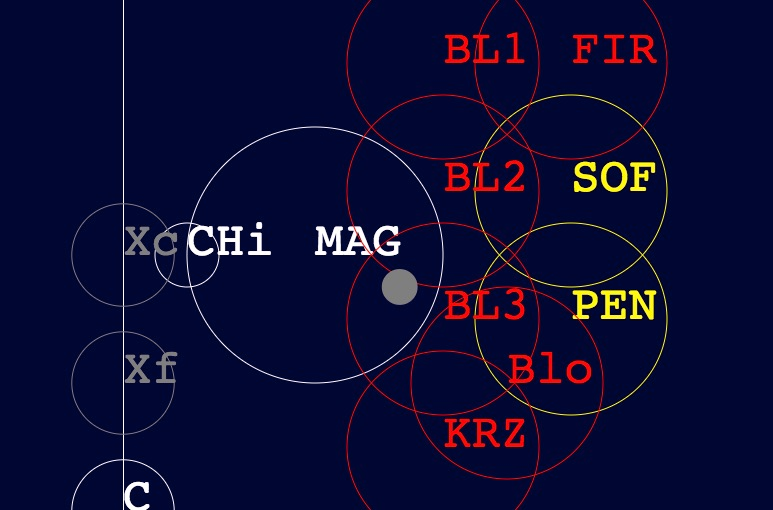
We manually laid out our animations on a 2D “terrain”, giving each of them an X/Y position and a radius. In some cases the animations overlapped and would play - or crossfade - at the same time.
Our generator functions already took parameters for spacial position (for each display point), and elapsed time. We added another two: distance and compass heading of the animation relative to the terrain cursor. An animation could choose to treat this navigational distance as an instruction to fade in or out (and in fact, we had a higher-order generator which applied a fade according to distance). And any animation out of range of the cursor was ignored for the purposes of rendering.
Cues from the audio system came in to the host machine via OSC; we used a Max patcher to turn that into a web socket message in order to get it into the browser. Every cue would kick off a cursor move to a specific X/Y point to take place in a time T. (Our almost-throwaway project Twizzle7 was a perfect tool to support the cue following.)
The actual hardware control was via video capture, using the NovaStar controller to send data signals via ethernet to the LED controllers. We ran the pre-visualisation full-screen in the Chrome browser, mirroring output to the HDMI capture device to drive the installation.
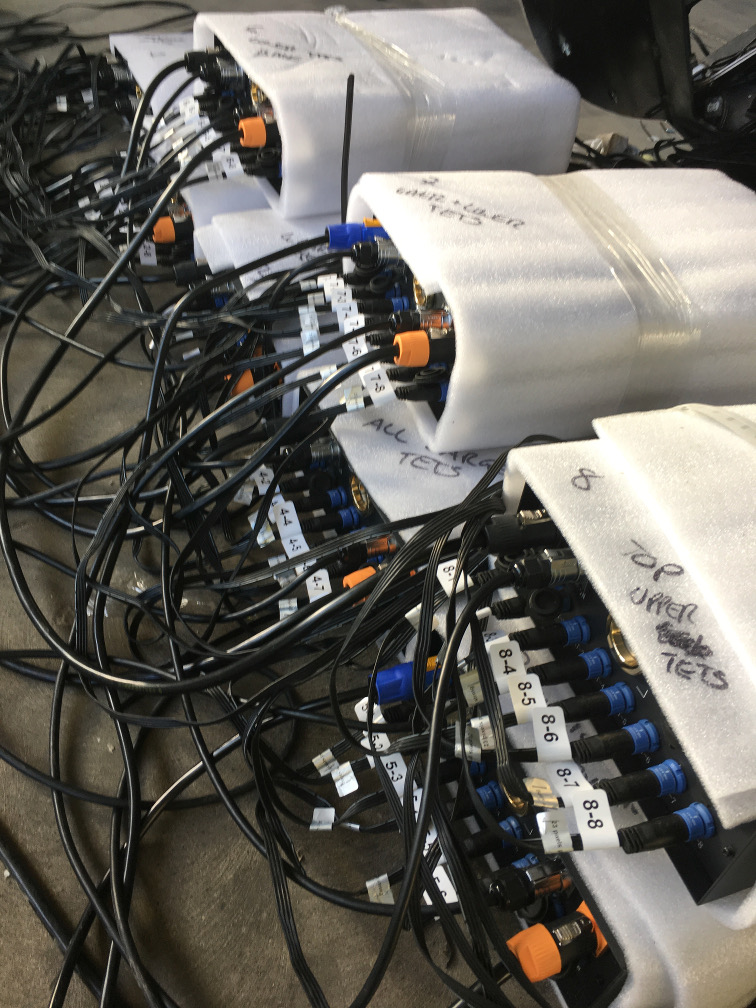
To generate the pixel patterns for the controller we put another HTML canvas into the application page, brought up a 2D drawing context, and drew into it by fast-updating an RGB byte array:
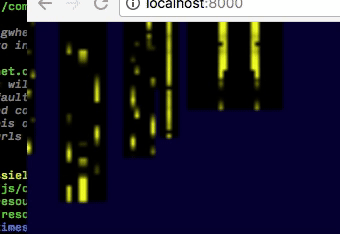
We conclude with a time-lapse video of the Holohedron in action.
Figure 10: The Cosmoscope Holohedron in Action
Nelson, Simeon. Anarchy in the Organism, Black Dog Publishing, 2013↩︎
Nelson, Simeon. Plenum. https://www.lumiere-festival.com/programme-item/plenum/↩︎
Simeon Nelson – Cosmoscope – Crown Court Diamonds. https://artav.co.uk/simeon-nelson-cosmoscope/↩︎
Emscripten: a complete compiler toolchain to WebAssembly. https://emscripten.org/↩︎
Jitter. Cycling ’74. https://cycling74.com/products/jitter↩︎
Rothwell, Nick. AudioMulch 2.0. Sound On Sound, November 2009. https://www.soundonsound.com/reviews/audiomulch-20↩︎
Rothwell, Nick. Twizzle: a simple Clojure “nano-automation” library for animation systems. https://github.com/cassiel/twizzle↩︎